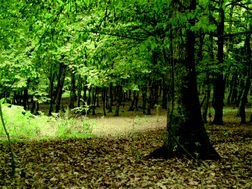Following the ratification of the Kyoto Protocol, afforestation of formerly arable lands and/or degraded areas has been acknowledged as a land-use change contributing to the mitigation of increasing atmospheric CO2 concentration in the atmosphere. In the present work, we study the soil organic carbon sequestration (SOCS) in 21 year old stands of maple (Acer velutinum Bioss.), oak (Quercus castaneifolia C.A. Mey.), and red pine (Pinus brutia Ten.) in the Darab Kola region, north of Iran. Soil samples were collected at four different depths (0–10, 10–20, 20–30, and 30–40 cm), and characterized with respect to bulk density, water content, electrical conductivity, pH, texture, lime content, total organic C, total N, and earthworm density and biomass. Data showed that afforested stands significantly affected soil characteristics, also raising SOCS phenomena, with values of 163.3, 120.6, and 102.1 Mg C ha−1 for red pine, oak and maple stands, respectively, vs. 83.0 Mg C ha−1 for the control region. Even if the dynamics of organic matter (OM) in soil is very complex and affected by several pedo-climatic factors, a stepwise regression method indicates that SOCS values in the studied area could be predicted using the following parameters, i.e., sand, clay, lime, and total N contents, and C/N ratio. In particular, although the chemical and physical stabilization capacity of organic C by soil is believed to be mainly governed by clay content, regression analysis showed a positive correlation between SOCS and sand (R = 0.86**), whereas a negative correlation with clay (R = −0.77**) was observed, thus suggesting that most of this organic C occurs as particulate OM instead of mineral-associated OM. Although the proposed models do not take into account possible changes due to natural and anthropogenic processes, they represent a simple way that could be used to evaluate and/or monitor the potential of each forest plantation in immobilizing organic C in soil (thus reducing atmospheric C concentration), as well as to select more appropriate species during forestation plan management at least in the north of Iran.


 Please wait while we load your content...
Please wait while we load your content...